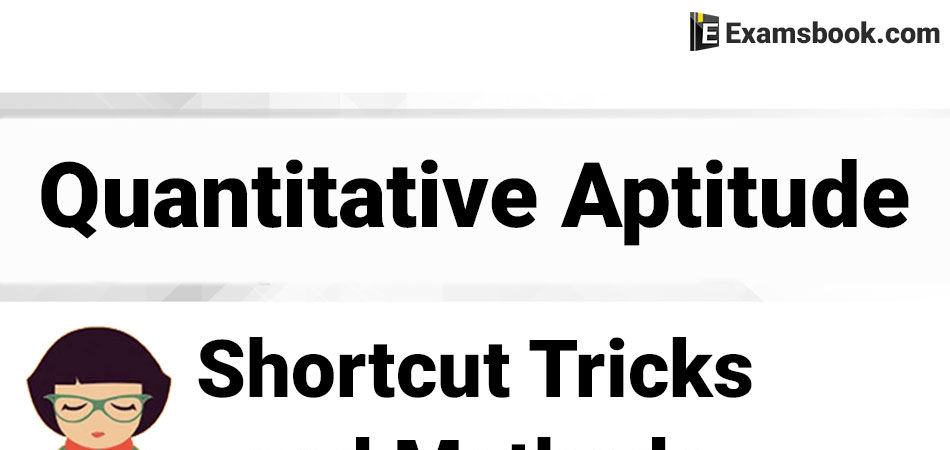Quantitative Aptitude Shortcut Tricks and Methods for Competitive Exam

Students always take time to complete the quantitative aptitude questions paper in the competitive exams, in which they have to left some of the questions. So, here in this blog, I am sharing quantitative aptitude shortcut tricks and methods, to keeping in mind your problem.
So, you should know these quantitative aptitude shortcut tricks and methods to save your time and to make better performance in the competitive exams. Let's practice with tricks which will help to improve your mental skills also. Here are the Top 100 quantitative Aptitude questions which are very important for your competitive exams.
Shortcut Tricks and Methods of Quantitative Aptitude:
Q.1. The least prime number is
(A) 0
(B) 1
(C) 3
(D) 2
Solution
A natural number other than 1, is a prime number if and only if it is divisible by 1 and the number itself. Thus, the least prime number is 2.
Q.2. Find the least number which divided by 12, 18, 36 and 45 leaves the remainder 8,14, 32 and 41 respectively.
Solution
Here, 12-8 = 18-4=36-32=45-41=4
⸫ The required number = (LCM of 12, 18,36 and 45)-4
2 | 12,18,36,45 |
2 | 6,9,18,45 |
2 | 3,9,9,45 |
3 | 1,3,3,15 |
3 | 1,1,1,5 |
5 | 1,1,1,1 |
LCM = 2*2*3*3*5=1800
⸫ The required number = 180-4 = 176
Q.3. An empty pool being filled with water at a constant rate takes 8 h to fill 3/5th of its capacity. How much more time will it finish filling the pool ?
Solution
Time taken to fill the 3/5th part of a pool = 8h
Remaining part = [ 1 – (3/5)]
= [(5-3)/5]=2/5th
⸫ Time taken to fill the 2/5th part of a pool = (8*2*5*)/(5*3) = 16/3
=5 1/3 = 5 h 20 min.
Q.4. P can do a piece of work in 9 days. Q is 50% more efficient than P. The number of days it takes for Q to do the same piece of work is .
Solution
Let efficiency of P be 1.
⸫ Efficiency of Q=1+50% of the efficiency of P.
= 1 +(50/100)×1 = 1+(1/2)= 3/2
Since, P can do a piece of work in 9 days.
Then, Q can do a piece of work in 9*(2/3) = 6 days.
Q.5. 16 men can complete a work in 15 days, 24 children can do same work in 20 days. In how many days will 8 men and 8 children, complete the same work?
Solution
∵ 16 men can do a piece of work in 15 days.
⸫ 1 man can do a piece of work in 1 days = 1 /(15*16) = 1/240
Similarly,
1 child can do a piece of work in
1 day = 1/24*20 = 1/480
So, 240 men’s one day work = 480
Children’s one day work or 1 man’s one day work = 2
Children’s one day work
⸫ 8 men + 8 children
= (8*2+8) children
= (16+8) children = 24 children
Then, 24 children can do a piece of work in 480/24 i.e., 20 days.
Q.6. The area of the iron sheet required to prepare a cone 24 cm high with bas radius 7 cm is (Take π = 22/7)
Solution
Here, height of a cone, h= 24 cm
Radius of the base, r = 7 cm
⸫ Slant height l = $$=\sqrt { h^2 +r^2} \ $$
$$=\sqrt {24^2 +7^2} \ $$
$$=\sqrt {576 +49} \ $$
$$=\sqrt {625} \ =25\ cm$$
⸫ Are of the iron sheet = Total surface area of the cone.
= πrl + πr2 = πr(l+r)
= (22/7) * 7(25+7)
= 22 * 32 = 704 cm2
Q.7. On decreasing each side of and equilateral triangle by 2 cm, there is a decrease of 4√3 cm2 in its area. The length of each side of the triangle is
Solution
Let each side of an equilateral be x.
⸫ Area of an equilateral triangle
$$ {\sqrt {3 } \ \over4} x^2 $$
On decreasing each side of an equilateral triangle by 2 cm. Then, new side = ( x-2) cm
⸫ Area of new equilateral triangle
$$ {\sqrt {3 } \ \over4} (x-2)^2 $$
According to the question
$$= {\sqrt {3 } \ \over4} x^2 -{\sqrt {3 } \ \over4} (x-2)^2 = 4\sqrt {3 } \ $$
$$→{\sqrt {3 } \ \over4}[x^2-x^2+4x-4]=4\sqrt { 3} \ $$
$$ →{\sqrt {3 } \ \over4}(4x-4) =4\sqrt { 3} \ $$
4x-4=16→4x=20
→ x=5cm
Hence, the length of each side is 5 cm.
Without any hesitation, you can ask me anything in the comment section related quantitative aptitude shortcut tricks and methods. Visit on the next page for more practice or know more tricks and methods.



